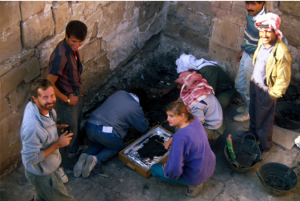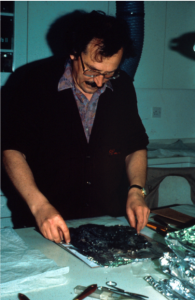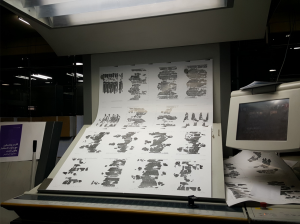The Petra Church and Petra Papyri
ACOR undertook the work of excavation, restoration and shelter construction of the Petra Church from 1992 to 1998. In recent years there have been many phases of conservation (see ACOR Newsletter 23.2-Winter 2011). Based on the excavations we can state that this complex was first built around A.D. 450 by members of the Christian community living in Petra and there was a fire that destroyed parts of the church around A.D. 600, including the room which contained papyrus scrolls. These sixth-century texts written in Greek indicate that the church was dedicated to the Virgin Mary. ACOR has published five volumes on The Petra Papyri as well as a beautiful book about the excavations published in 2001 The Petra Church (see Publications). ACOR welcomes support for the ongoing conservation and site maintenance of the Petra Church.
To understand the importance of the church, a brief summary of what can be seen when visiting Petra is provided here. The shelter protects the wonderful mosaics in the main part of the church. Most of the south aisle is occupied by the Mosaic of the Seasons— so called due to the four figures in the central column identified by Greek inscriptions as personifications of the Seasons (with interesting details of dress and jewelry). The design of the mosaic on the north side is composed of a pattern called an inhabited vine scroll in which vine tendrils emerge from a vase at the western end and form frames for medallions which include pairs of animals as well as six human figures. The human figures show the mastery of the mosaicists in creating the faces with very small tesserae.
Most of the marble pavement of the nave and chancel was robbed in antiquity. Some fragments remained and there were also traces of the pattern on the mortar bedding. Because of this evidence, ten individual sections (nine patterns) were identified. The tenth section at the atrium entrance is protected by a metal grate. The main name was reconstructed around the original fragments with modern stone recreating the ancient pattern. The fragile opus sectile section in the atrium needs ongoing conservation and protection and part of ACOR’s Church Conservation Endowment will be used for that.
In 1993, the cache of approximately 140 papyrus scrolls were found in a room northeast of the church proper. They had been carbonized in a fire and were thus preserved. Such discoveries are exceedingly rare in the Near East except for Egypt. The Petra papyri texts are often dated—ca. 537 to 594–thanks to the law promulgated by the Byzantine Emperor Justinian to place the date at the beginning and end of a document. The scrolls vary in size from a single sheet as P. Petra 6 (L. 28 cm), a list of stolen goods, to the exceptionally long P. Petra 2 (L. 8.5 m), which is an agreement concerned with inherited property. These documents deal with real estate transactions, disputes, contracts, divisions of property, marriages, dowries, and inheritance. The central figures of the archive are Theodoros, son of Obodianos, who was deacon and later archdeacon in the church, and his extended family and peers. The language indicates that the people in Petra at this time were speaking an early form of Arabic.
A team of papyrologists from Finland conserved these sixth century texts from 1994 to 1995 at ACOR in Amman as part of a major effort headed by Jaakko Frösén. The original fragments were placed on Japanese rice paper and sandwiched between glass plates so they could be preserved and examined for study. Some scrolls are written on both sides (and they could not be mounted on paper) but most are single-sided. As noted, many texts have been translated and published in The Petra Papyri series (Amman: ACOR) by scholars from Finland and the University of Michigan. Some documents are exhibited at the Jordan Museum in Amman.





